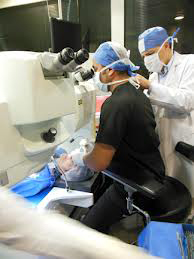- Contact Us
- |
- Sitemap
- |
- Home


Custom LASIK is a procedure that involves the use of a wave-front analyzer which enables your surgeon to customize the conventional LASIK procedure to your individual eye. This customized procedure can result in patients seeing clearer and sharper than ever before.
Custom LASIK uses equipment called the wave-front analyzer (aberrometer) to accurately
measure the way light travels through the eye. The resulting map of the eye is then
programmed into the laser, and the laser treats the eye based on the personalized
3-D map.
LASIK procedure -step-by-step: LASIK Knowledge Centre : LASIK procedure -step-by-step:
First, the eye surgeon uses an instrument known as a microkeratome to make a thin
flap of the outer layer of the cornea. Then he folds back the flap, which remains
attached on one side. Next, he uses the cool laser light from the Excimer laser
to 'ablate'' i.e. remove the pre-determined amount of tissue to reshape the cornea
with great accuracy and corrects the individual's refractive error. The cornea is
made flatter to treat near-sightedness, and steeper to treat far-sightedness and/or
more spherical to correct astigmatism. AFinally, after the laser is administered,
he lays back the corneal flap in its original position, where it bonds itself instantly.
Due to the extraordinary natural bonding qualities of the cornea, no stitches or
sutures are required. An eye-patch is not required.
Suitability :
Custom LASIK helps to treat 'higher order' aberrations, which are tiny imperfections in the optical system of the eye. They have a significant impact on quality of vision. In fact, higher order aberrations have been linked to visual glare and halos. Higher order aberrations have not been previously treatable with contact lenses, glasses or conventional LASIK.

Benefits of custom LASIK :
Clinical studies have shown that Custom LASIK can improve not only what you can
see but also how well you can see. In the past, doctors used a standard vision chart
to measure vision.
If you could see the letters, the doctor would proclaim your vision as a number, such as 20/20, 20/100, and so on. But now, with Custom LASIK, doctors are also able to focus on the quality of your vision. Many patients who have undergone the Custom LASIK procedure, report clearer vision than ever before. It is as if someone had taken an ink-pad and freshly stamped each letter on the vision-chart in bold black letters.
Since Custom LASIK corrects the unique imperfections in each individual's vision, it is likely that the patient will have improved night-vision.
Conventional refractive surgery such as LASIK or PRK only treats lower order aberrations like Defocus (Myopia, Hypermetropia) and Astigmatism. It is well known that there is a potential to induce higher order aberrations of 3rd, 4th, 5th order.
Custom corneal ablation can treat lower order aberrations, but it also has the potential to resolve higher order aberrations such as Coma, Trefoil and others.
Custom corneal ablation is a combination of two components:
a) Aspheric ablation:To preserve the prolate shape of the cornea & to decrease the risk for induced spherical aberrations and night symptoms of glare and halos.
b) Multipoint ablation:
Using a 1mm spot to treat and irregularity component.
It is divided in to 2 modalities of optional treatments:
It has the ability to diagnose, analyze and to perform custom ablation. There are 3 components :
This may be performed for primary cases or for enhancement treatments. Criteria that a refractive surgeon should consider for performing custom ablations are :